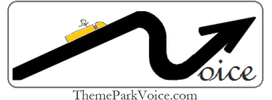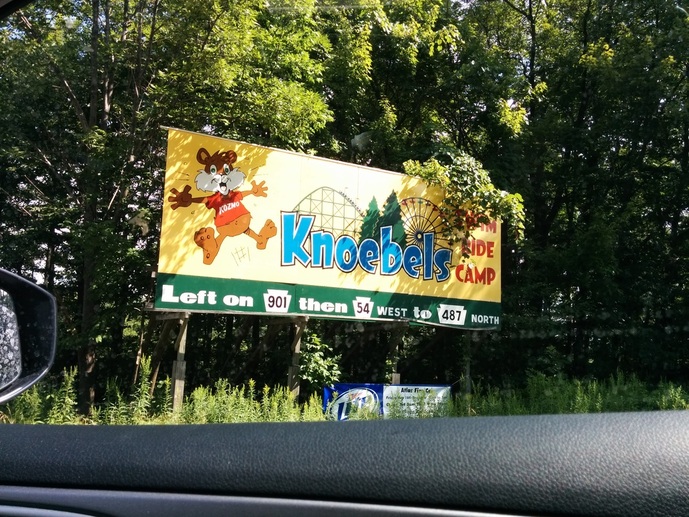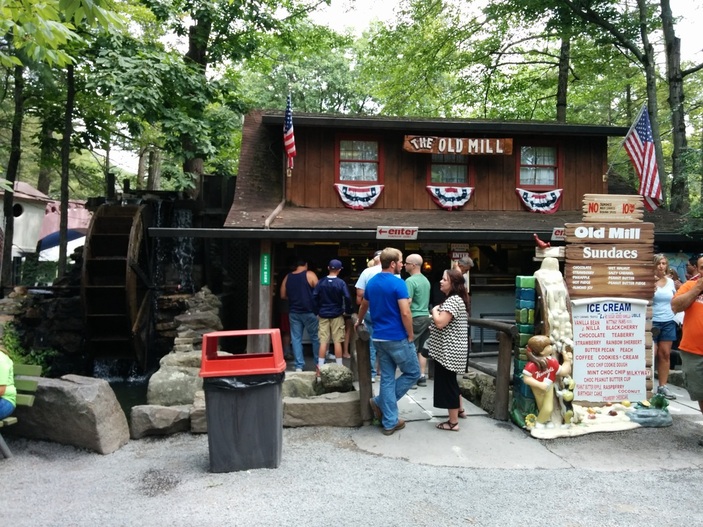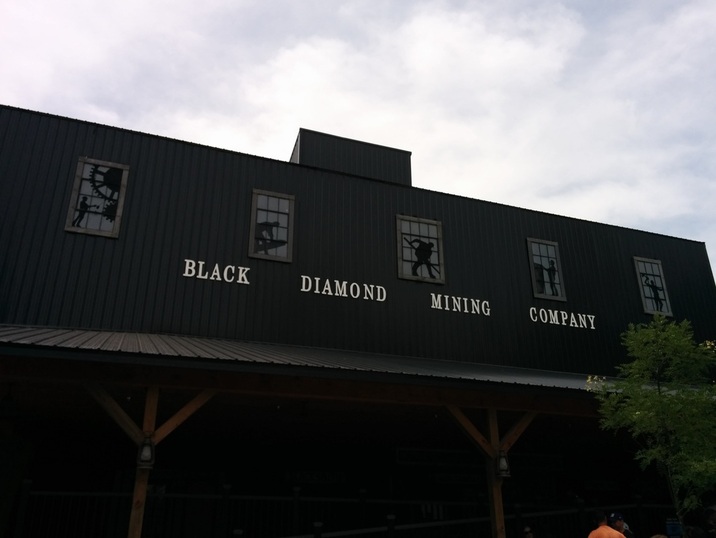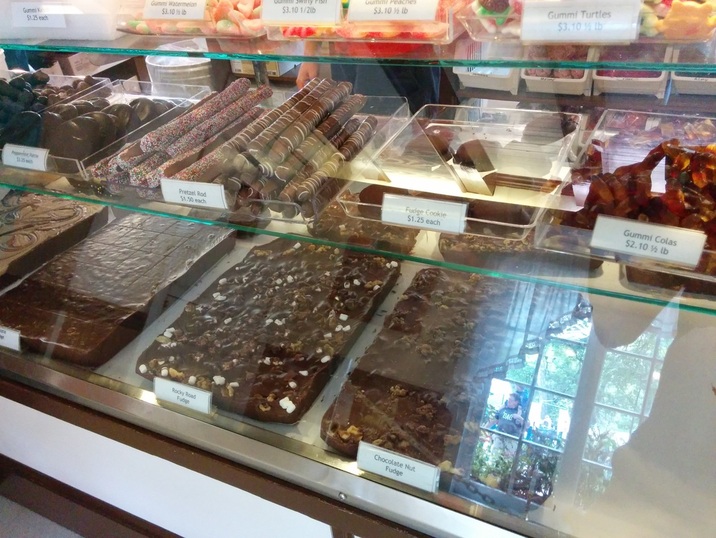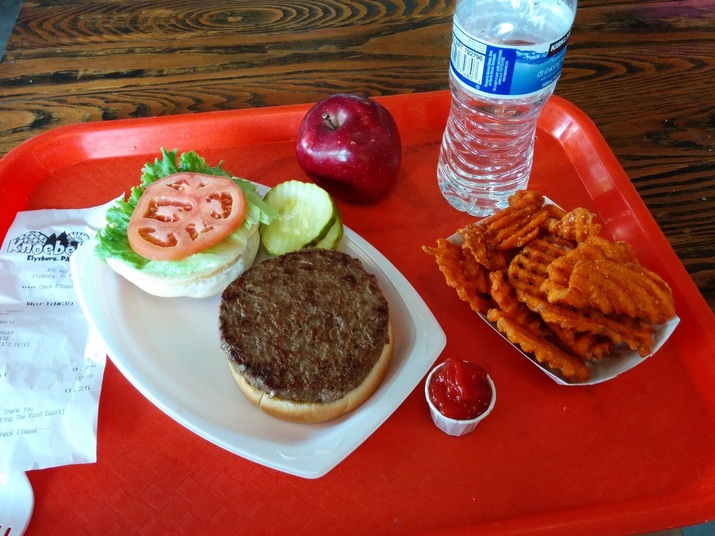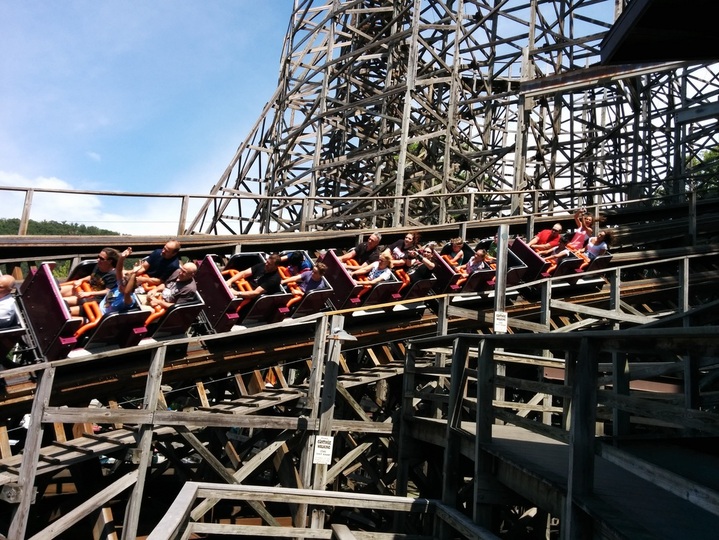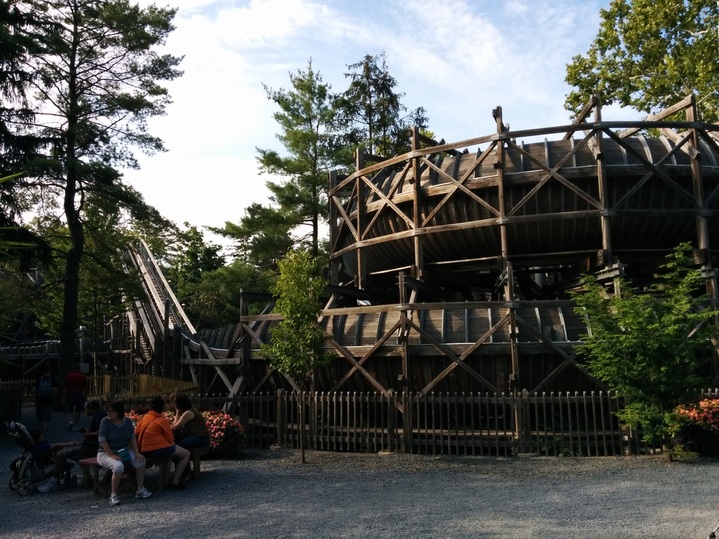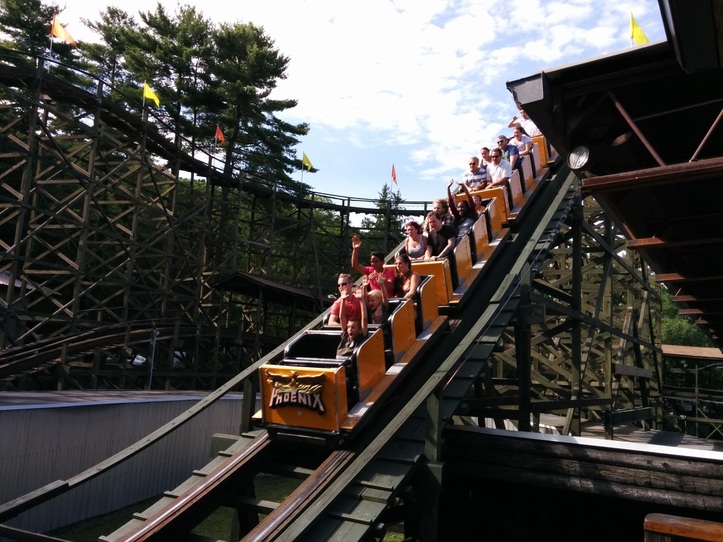Trip Reports
Master's Scholarship Day 1: Knoebels 16/08/14
How the hell did I get to do this exactly?
In 2004, when I was ten years old, I first saw the television adverts for Thorpe Park’s new rides, Nemesis Inferno and Colossus, and I was completely captivated. I was lucky enough to have my parents take me to many amusement parks as a small child; I was a huge LEGO fan so we had been to LEGOLand, my grandparents lived near Drayton Manor in Staffordshire so we had been there a number of times and we had also been to Disneyland Paris, amongst a few others. But I had never really found an enthusiasm for them. In fact a few weeks before I saw these adverts my parents had taken my younger sisters and I to Alton Towers for a couple of nights, and although I had been very excited about the legendary huge rides (I distinctly remember my Dad telling me about Oblivion, the vertical drop coaster, which one of his colleagues had told him about) I didn’t pluck up the bravery to do any of the major attractions, even discouraging my sisters from doing one of the rides because I thought it looked unsafe. But for some reason these adverts really clicked with me (if only Thorpe could rehire that marketing department), and I begged my parents to take me. Of course they said no, reminding me that I hadn’t done any of the rides at Alton, and they were aware that Thorpe was geared more for the older kids. But I persisted, and eventually they caved, on the condition that I actually did go on the two big roller coasters. I agreed, and despite being terrified I forced myself on Nemesis Inferno and of course absolutely loved it. The rest is history (I’ve now been to Thorpe a frankly disgusting twenty times). That evening we ate out at a restaurant, and on the paper napkin I sketched my own theme park; from that moment I wanted to design these things, and it’s a goal that I still haven’t given up on ten years later.
I’m now at university studying engineering, still with the intention of designing amusement rides one day, and that’s where the story of my travels begins. My university is well known for having quite a lot of money, and just one example of this is that my college (one of many that make up the university) offers a summer vacation travel scholarship to the United States. The idea is that it will serve to complement and enhance your academic studies, and so during the application process and interview you have to make sure this is the case. As the “I WANT TO GO TO DISNEYLAND” route probably wouldn't have worked (N.B no Disney parks were , or were ever planned to be, involved), and as this is legitimately what I want to do with my life, I explained all of this tedious nonsense you have just read to my college, and by some miracle, and a little puppydog eyes, I got it.
The obvious issue is that although theme parks are the homes of the rides, they are not where they’re designed and fabricated. Very few theme parks build their own rides. It’d be like getting an internship with Sports Direct because you want to design Nike shoes. Or like getting an internship with O2 because you want to write software for the iPhone. But, just like Sainsbury’s selling own brand vodka, some parks do indeed build their own rides in house. Except one of them doesn’t cause headaches, blindness and the occasional aneurysm. Disney and Universal are the most notable, and they can do it because they have the cash to invest in infrastructure and employees, and enough parks to make it worthwhile, but they are so big that understandably they won’t show individuals around their operations. The main reason for my choice of location was quite simply the proximity of good parks, but a secondary factor was that two of the very few other parks worldwide that build their own rides were within touching distance. The first of these was Knoebels.
Day 1: Knoebels 16/08/14
I based myself for the week in Harrisburg, a fairly small town right next to the similarly fairly small town of Hershey (of chocolate and theme park fame), a rural area near the centre of Pennsylvania. My plan for the week was very simple: hire a car (which was barely allowed since I’m 20: most places require you to be 25, and virtually all places require 21) and drive to each park and back each day. Knoebels is just an hour away from Harrisburg, and since the first day was a Saturday I wanted the park that was likely to be the least busy, which I thought would be the case since it’s comparatively less known. After an hour of driving on the wrong side of the road, which is really very straightforward, I arrived at the little amusement park, which is nestled in the woods of Elysburg.
In 2004, when I was ten years old, I first saw the television adverts for Thorpe Park’s new rides, Nemesis Inferno and Colossus, and I was completely captivated. I was lucky enough to have my parents take me to many amusement parks as a small child; I was a huge LEGO fan so we had been to LEGOLand, my grandparents lived near Drayton Manor in Staffordshire so we had been there a number of times and we had also been to Disneyland Paris, amongst a few others. But I had never really found an enthusiasm for them. In fact a few weeks before I saw these adverts my parents had taken my younger sisters and I to Alton Towers for a couple of nights, and although I had been very excited about the legendary huge rides (I distinctly remember my Dad telling me about Oblivion, the vertical drop coaster, which one of his colleagues had told him about) I didn’t pluck up the bravery to do any of the major attractions, even discouraging my sisters from doing one of the rides because I thought it looked unsafe. But for some reason these adverts really clicked with me (if only Thorpe could rehire that marketing department), and I begged my parents to take me. Of course they said no, reminding me that I hadn’t done any of the rides at Alton, and they were aware that Thorpe was geared more for the older kids. But I persisted, and eventually they caved, on the condition that I actually did go on the two big roller coasters. I agreed, and despite being terrified I forced myself on Nemesis Inferno and of course absolutely loved it. The rest is history (I’ve now been to Thorpe a frankly disgusting twenty times). That evening we ate out at a restaurant, and on the paper napkin I sketched my own theme park; from that moment I wanted to design these things, and it’s a goal that I still haven’t given up on ten years later.
I’m now at university studying engineering, still with the intention of designing amusement rides one day, and that’s where the story of my travels begins. My university is well known for having quite a lot of money, and just one example of this is that my college (one of many that make up the university) offers a summer vacation travel scholarship to the United States. The idea is that it will serve to complement and enhance your academic studies, and so during the application process and interview you have to make sure this is the case. As the “I WANT TO GO TO DISNEYLAND” route probably wouldn't have worked (N.B no Disney parks were , or were ever planned to be, involved), and as this is legitimately what I want to do with my life, I explained all of this tedious nonsense you have just read to my college, and by some miracle, and a little puppydog eyes, I got it.
The obvious issue is that although theme parks are the homes of the rides, they are not where they’re designed and fabricated. Very few theme parks build their own rides. It’d be like getting an internship with Sports Direct because you want to design Nike shoes. Or like getting an internship with O2 because you want to write software for the iPhone. But, just like Sainsbury’s selling own brand vodka, some parks do indeed build their own rides in house. Except one of them doesn’t cause headaches, blindness and the occasional aneurysm. Disney and Universal are the most notable, and they can do it because they have the cash to invest in infrastructure and employees, and enough parks to make it worthwhile, but they are so big that understandably they won’t show individuals around their operations. The main reason for my choice of location was quite simply the proximity of good parks, but a secondary factor was that two of the very few other parks worldwide that build their own rides were within touching distance. The first of these was Knoebels.
Day 1: Knoebels 16/08/14
I based myself for the week in Harrisburg, a fairly small town right next to the similarly fairly small town of Hershey (of chocolate and theme park fame), a rural area near the centre of Pennsylvania. My plan for the week was very simple: hire a car (which was barely allowed since I’m 20: most places require you to be 25, and virtually all places require 21) and drive to each park and back each day. Knoebels is just an hour away from Harrisburg, and since the first day was a Saturday I wanted the park that was likely to be the least busy, which I thought would be the case since it’s comparatively less known. After an hour of driving on the wrong side of the road, which is really very straightforward, I arrived at the little amusement park, which is nestled in the woods of Elysburg.
First off, for those who like reading out loud, or are reading this to your kids at bed time, it’s pronounced “Kuh-NOE-bulls”; the ‘K’ is not silent. It’s just a name; the name of the family who have owned and run the park since it opened in 1926. From the car park there is an endless stream of helpful employees ready to shuttle you down to the park in golf buggies. I had been in correspondence with Dick Knoebels, the president and co-manager of the park, to see if he could accommodate me for part of the day to take a look at some of the onsite engineering. He very graciously agreed, and since he spends most of his time helping out with operations around the park I was asked to try to walkie talkie him via an employee. At first we couldn’t find him so I was advised to enjoy the park for a couple of hours before trying. I didn’t take much convincing.
The Park
Knoebels is known for a number of things. Firstly, it is a very traditional amusement park. The vast majority of rides could be (and many are) over fifty years old. They do have a few modern rides thrown in, but most are reminiscent of the Golden Age of Roller Coasters. Secondly, going along with the first idea, admission is free and you buy tickets on a ride-by-ride basis. The park also owns a camping ground right next door, and this allows campers to visit the park without necessarily going on any rides and so without paying. Thirdly, it’s known for its food. The park was absolutely packed that day; Dick told me he thought there were probably between 25000 and 30000 people there (that’s virtually the maximum parks like Thorpe Park or Alton Towers would ever get), and yet the queues for rides were not long at all, the queues for food were legitimately a lot longer. They serve virtually every American treat you can imagine as well as a lot of international food across dozens of restaurants, fast food stalls, stands and carts, and many regard the park as having the very best amusement park food in the World.
The Park
Knoebels is known for a number of things. Firstly, it is a very traditional amusement park. The vast majority of rides could be (and many are) over fifty years old. They do have a few modern rides thrown in, but most are reminiscent of the Golden Age of Roller Coasters. Secondly, going along with the first idea, admission is free and you buy tickets on a ride-by-ride basis. The park also owns a camping ground right next door, and this allows campers to visit the park without necessarily going on any rides and so without paying. Thirdly, it’s known for its food. The park was absolutely packed that day; Dick told me he thought there were probably between 25000 and 30000 people there (that’s virtually the maximum parks like Thorpe Park or Alton Towers would ever get), and yet the queues for rides were not long at all, the queues for food were legitimately a lot longer. They serve virtually every American treat you can imagine as well as a lot of international food across dozens of restaurants, fast food stalls, stands and carts, and many regard the park as having the very best amusement park food in the World.
Phoenix
The fourth thing that Knoebels is known for is its legendary Phoenix wooden roller coaster, which was the main draw for me, and the first ride of the trip. The ride was originally built way back in 1946 in Texas under the name ‘Rocket.’ Its home, Playland Park, closed in 1980 and five years later Knoebels lovingly agreed to give it a new home, the name Phoenix presumably representing its rise from the ashes of the Rocket. Despite its age and travels the ride is consistently rated as a top 10 coaster in the World even now, and so I had very high hopes, fully expecting it to take my top spot. The ride stands only 78ft tall and hits a fairly placid top speed of 45mph, but this does not tell the whole story. What makes it stand out are the multiple runs of ridiculous airtime hills, during which you get hurled violently out of your seat over and over. This is one of the few coasters where, if it weren't for the restraints, you would not be in the train when it returns to the station. With the short queues, and at just $2.50 a pop (surely the best value for money roller coaster in the World?), I took a ride in a number of different seats, but honestly none blew me away. The ride is certainly world class; it is incredibly well maintained considering its age, and it blends the usual wooden rattle with a gloriously smooth circuit. The first drop is decent at the back, but as it is only 72ft it's virtually nonexistent at the front. It cannot be denied that the signature airtime hills are fantastic; they get more and more extreme as the ride goes on and by the end I had no option to cling on for dear life, but overall I was left a little disappointed. That being said it placed firmly in the middle of my top 10 (to be slowly displaced to 10th over the course of the week), I just had my expectations a little too high. Once thing I noticed almost instantly was just how damned happy American people are at amusement parks. I'm very used to Brits returning to the stations of roller coasters looking like they've just finished a double geography lesson, so it was a welcome change to see so many smiling faces.
The fourth thing that Knoebels is known for is its legendary Phoenix wooden roller coaster, which was the main draw for me, and the first ride of the trip. The ride was originally built way back in 1946 in Texas under the name ‘Rocket.’ Its home, Playland Park, closed in 1980 and five years later Knoebels lovingly agreed to give it a new home, the name Phoenix presumably representing its rise from the ashes of the Rocket. Despite its age and travels the ride is consistently rated as a top 10 coaster in the World even now, and so I had very high hopes, fully expecting it to take my top spot. The ride stands only 78ft tall and hits a fairly placid top speed of 45mph, but this does not tell the whole story. What makes it stand out are the multiple runs of ridiculous airtime hills, during which you get hurled violently out of your seat over and over. This is one of the few coasters where, if it weren't for the restraints, you would not be in the train when it returns to the station. With the short queues, and at just $2.50 a pop (surely the best value for money roller coaster in the World?), I took a ride in a number of different seats, but honestly none blew me away. The ride is certainly world class; it is incredibly well maintained considering its age, and it blends the usual wooden rattle with a gloriously smooth circuit. The first drop is decent at the back, but as it is only 72ft it's virtually nonexistent at the front. It cannot be denied that the signature airtime hills are fantastic; they get more and more extreme as the ride goes on and by the end I had no option to cling on for dear life, but overall I was left a little disappointed. That being said it placed firmly in the middle of my top 10 (to be slowly displaced to 10th over the course of the week), I just had my expectations a little too high. Once thing I noticed almost instantly was just how damned happy American people are at amusement parks. I'm very used to Brits returning to the stations of roller coasters looking like they've just finished a double geography lesson, so it was a welcome change to see so many smiling faces.
Next I tried out another relocated roller coaster, Black Diamond. Black Diamond originally opened in 1960 in New Jersey, and was one of the earliest steel tracked roller coasters. It’s a very small, theoretically family friendly roller coaster, but when Knoebels rebuilt it in 2011 they clearly decided it needed a little extra edge, and so have put it indoors and themed it to an incredibly creepy diamond mine. The animatronics are actually very effective; there’s a cart-pulling mule, multiple seemingly undead miners and eventually a very simple but very impressive effect of a tunnel boring machine drilling through the walls and towards you. Because of the stop-start nature of the ride it feels very long, and although the drops aren’t big or frequent they are very sudden. Despite the ghoulish theme it is really a family ride, and it’s a great fit for the park.
The Food
My trip took a great deal of planning, most of which went into food research. I had lists of exactly where I was going to go and what I was going to eat, and by this point I felt I needed to begin in order to remain on schedule. I headed for what is probably the most delicious smelling place I have ever had the pleasure of sniffing: Stony Gables Fudge Shoppe. The ‘shoppe’ is a traditional fudge house which also serves freshly roasted nuts, and the combo is a wonder for the nostrils. I tried out their peanut butter and chocolate ‘Wurzel’, a kind of slush puppy/milkshake hybrid, which is supposedly highly regarded. It was tasty, but without any interesting chunks in it it became monotonous quite quickly so I only bothered with half of it (this was early days, and I was struggling to get into the unhealthy mindset).
My trip took a great deal of planning, most of which went into food research. I had lists of exactly where I was going to go and what I was going to eat, and by this point I felt I needed to begin in order to remain on schedule. I headed for what is probably the most delicious smelling place I have ever had the pleasure of sniffing: Stony Gables Fudge Shoppe. The ‘shoppe’ is a traditional fudge house which also serves freshly roasted nuts, and the combo is a wonder for the nostrils. I tried out their peanut butter and chocolate ‘Wurzel’, a kind of slush puppy/milkshake hybrid, which is supposedly highly regarded. It was tasty, but without any interesting chunks in it it became monotonous quite quickly so I only bothered with half of it (this was early days, and I was struggling to get into the unhealthy mindset).
I spent a while after this exploring the park; there are so many nooks and crannies, and I spent a long time watching people eat the ridiculous variety of food. I realised very quickly that I wouldn’t be able to manage/didn’t really want all the food on my list, and so I dined vicariously. They have every food you can imagine on a stick; pork chops, shrimp, corn dogs, toffee apples, candyfloss, they have alligator nuggets (for real), ice cream sandwiches, waffles and chicken, deep fried brownies, bison burgers (weren't they from Roller Coaster Tycoon?), caramel corn and virtually every regular fast food as well. I eventually settled on the bison burger, which honestly tasted no different from a regular beef burger, and attempted to get my hands on deep fried brownies only to find that they only serve them in the fall.
Twister
After my first session of pigging out I headed for the park’s largest roller coaster; Twister. This is an original coaster, built in 1999, but it is based on one of famed designer John Allen’s designs. It is not a very highly rated ride, and it far exceeded expectations. It starts with a weird two part lift hill (presumably to save space) before two very big drops, both of which hurl you from your seat. After that it’s pretty much just very aggressive banking with a little airtime thrown in, but after those two drops it doesn’t need much else. It’s a real thrill ride, and though it’s not as fun as Phoenix, it’s just as extreme. Over in this area of the park are a lot of smaller rides: there’s a kiddie coaster, Kozmo’s Kurves (Kozmo is the mascot of the park, he appears to be a chipmunk or a squirrel), which I didn’t try, a ferris wheel and a number of typical spinning rides.
After my first session of pigging out I headed for the park’s largest roller coaster; Twister. This is an original coaster, built in 1999, but it is based on one of famed designer John Allen’s designs. It is not a very highly rated ride, and it far exceeded expectations. It starts with a weird two part lift hill (presumably to save space) before two very big drops, both of which hurl you from your seat. After that it’s pretty much just very aggressive banking with a little airtime thrown in, but after those two drops it doesn’t need much else. It’s a real thrill ride, and though it’s not as fun as Phoenix, it’s just as extreme. Over in this area of the park are a lot of smaller rides: there’s a kiddie coaster, Kozmo’s Kurves (Kozmo is the mascot of the park, he appears to be a chipmunk or a squirrel), which I didn’t try, a ferris wheel and a number of typical spinning rides.
Meeting Dick
It was at this point that I realised I was actually supposed to be meeting up with Dick, and this time I managed to find him very quickly. He was evidently extremely preoccupied on such a busy day, so for him to give up his time for me was incredibly generous. Because so many of the rides are pretty old, the engineering behind many of them is fairly straightforward. With the major roller coasters the only really mechanical equipment is the drive motor for the lift hill, and Dick explained how each of the rides was geared as we whizzed past them in the golf buggy. The main thing he wanted to show me was the newest coaster, and the only one I hadn’t yet been on; Flying Turns. Flying Turns, once again, is a blast from the past; it’s a bobsled roller coaster, which is a dying breed in itself, but uniquely it’s made of wood. There were a few wooden bobsleds many years ago, but the most recent to open was in 1941, and it closed in 1974. Bobsleds are complicated by definition because the train is not fixed to the track; it runs in a trough, and this means the safety systems have to be incredibly rigorous. Also if an object falls on the track, whereas with a usual coaster it would just fall off the tubular rails, with a bobsled it will valley in the middle of the trough and sit right in the path of the car. For these reasons, despite the track work being completed in 2007, it has taken an incredible six years to open, undergoing numerous train redesigns. But the park’s perseverance has paid off; the ride was by far the most popular of the day. Dick even told me that, when at the IAAPA trade show in Orlando after Knoebels first announced the ride, one of the owners of a leading manufacturer told him that the task was simply impossible, and of course once it opened last year he received a very big congratulation from them. I was shown around the remarkable control room, which monitors every single inch of the ride via sensors and about forty video cameras. There are buffers that protrude from the trough to slow the train if needed, and the chain is lubricated only with water to prevent oil from getting into the trough. Dick very kindly let me get on the ride straight away, and it’s a whole lot of fun. Because of the narrowness of the trough the train is thrown much higher up the sides than on a regular bobsled, and it makes for a manic ride. Because of the obvious hassle I can’t see these rides catching on again anytime soon, but I think that’s a good thing; Knoebels has yet another unique jewel in its crown.
It was at this point that I realised I was actually supposed to be meeting up with Dick, and this time I managed to find him very quickly. He was evidently extremely preoccupied on such a busy day, so for him to give up his time for me was incredibly generous. Because so many of the rides are pretty old, the engineering behind many of them is fairly straightforward. With the major roller coasters the only really mechanical equipment is the drive motor for the lift hill, and Dick explained how each of the rides was geared as we whizzed past them in the golf buggy. The main thing he wanted to show me was the newest coaster, and the only one I hadn’t yet been on; Flying Turns. Flying Turns, once again, is a blast from the past; it’s a bobsled roller coaster, which is a dying breed in itself, but uniquely it’s made of wood. There were a few wooden bobsleds many years ago, but the most recent to open was in 1941, and it closed in 1974. Bobsleds are complicated by definition because the train is not fixed to the track; it runs in a trough, and this means the safety systems have to be incredibly rigorous. Also if an object falls on the track, whereas with a usual coaster it would just fall off the tubular rails, with a bobsled it will valley in the middle of the trough and sit right in the path of the car. For these reasons, despite the track work being completed in 2007, it has taken an incredible six years to open, undergoing numerous train redesigns. But the park’s perseverance has paid off; the ride was by far the most popular of the day. Dick even told me that, when at the IAAPA trade show in Orlando after Knoebels first announced the ride, one of the owners of a leading manufacturer told him that the task was simply impossible, and of course once it opened last year he received a very big congratulation from them. I was shown around the remarkable control room, which monitors every single inch of the ride via sensors and about forty video cameras. There are buffers that protrude from the trough to slow the train if needed, and the chain is lubricated only with water to prevent oil from getting into the trough. Dick very kindly let me get on the ride straight away, and it’s a whole lot of fun. Because of the narrowness of the trough the train is thrown much higher up the sides than on a regular bobsled, and it makes for a manic ride. Because of the obvious hassle I can’t see these rides catching on again anytime soon, but I think that’s a good thing; Knoebels has yet another unique jewel in its crown.
Once Dick had let me go, and with the sun setting, I bought my last set of ride tickets and got on the log flume. Like Loggers Leap at Thorpe Park it is hidden away in the woods until the final drop, which is very steep, and I luckily managed to avoid a complete drenching. I then did Phoenix a few more times before heading home. I missed a few rides: there is a fairly new drop tower called Stratosfear which had a very long queue all day, and there is also a Haunted House which is generally held in very high esteem.
Overall
You do feel the park may be held back a little in terms of its competition with other parks in the region by not building many modern rides, but they’re rectifying that next year by building their first modern steel looping coaster. Whilst Phoenix was below my expectations, the rest of the park was well above it; it’s a loved park by owners, employees and guests alike for good reason, and it truly shows.
Phoenix: 10/10
Twister: 8/10
Flying Turns: 7/10
Food: 7/10
Overall: 8/10
You do feel the park may be held back a little in terms of its competition with other parks in the region by not building many modern rides, but they’re rectifying that next year by building their first modern steel looping coaster. Whilst Phoenix was below my expectations, the rest of the park was well above it; it’s a loved park by owners, employees and guests alike for good reason, and it truly shows.
Phoenix: 10/10
Twister: 8/10
Flying Turns: 7/10
Food: 7/10
Overall: 8/10
